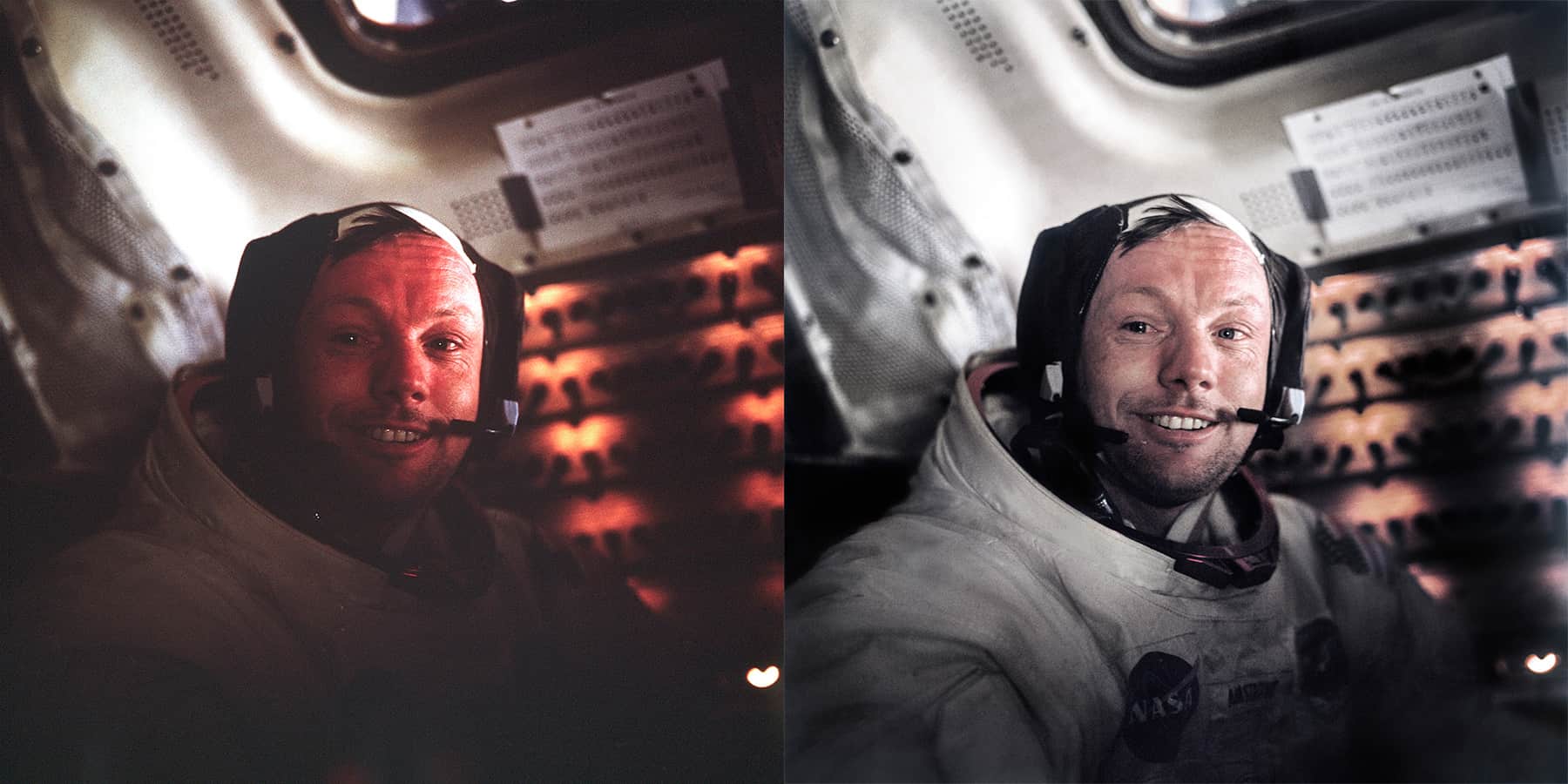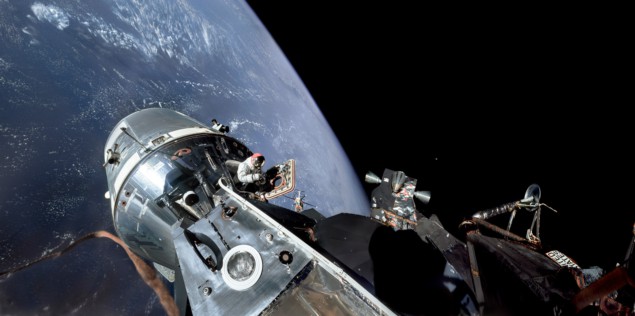Breathing new life into the iconic photos of NASA’s Apollo missions
11 Jan 2023
Andrew Glester reviews Apollo Remastered by Andy Saunders
Emerging view David Scott in the Command Module Hatch during Apollo 9. (Photo: Rusty Schweickart; courtesy: NASA /JSC /ASU /Andy Saunders)
If you’re a fan of space travel, chances are that you’ve already got coffee-table books featuring photographs from NASA’s Apollo missions. So you might be wondering whether you really need another one to add to your collection. In my opinion, the answer is yes – and the reason you do is evident as soon as you open Apollo Remastered by Andy Saunders.
This glossy photograph book takes readers from NASA’s first human-spaceflight programme, Project Mercury, through to the final Apollo mission in 1972. By using modern photography restoration techniques, and having trawled through the 35,000 images that make up the NASA archive, Saunders brings new life to images we have long since cherished and, in some cases, have never seen before.
The reader is taken inside command modules with a clarity that reveals teary eyed crew members. We go on space walks with Gemini astronauts and are given astounding views of the Earth and the Moon. We see the space capsule that delivered Neil Armstrong and Buzz Aldrin to the Moon’s surface and are treated to a gate-fold pull-out of the Apollo 17 Moon buggy set in a panorama around Shorty Crater. Towards the back of the book, Saunders also includes chapters on the development of space photography and the equipment the astronauts used on those historic trips. Before and after restoration A tired but elated Neil Armstrong in the Lunar Module after the historic first Moon walk. (Photo: Buzz Aldrin; courtesy: NASA; NASA /JSC /ASU /Andy Saunders)
Before and after restoration A tired but elated Neil Armstrong in the Lunar Module after the historic first Moon walk. (Photo: Buzz Aldrin; courtesy: NASA; NASA /JSC /ASU /Andy Saunders)
 Before and after restoration A tired but elated Neil Armstrong in the Lunar Module after the historic first Moon walk. (Photo: Buzz Aldrin; courtesy: NASA; NASA /JSC /ASU /Andy Saunders)
Before and after restoration A tired but elated Neil Armstrong in the Lunar Module after the historic first Moon walk. (Photo: Buzz Aldrin; courtesy: NASA; NASA /JSC /ASU /Andy Saunders)While there is no shortage of books on the Apollo missions, Saunders has made this one stand out in a crowded field. In the chapter titled “About the scans, image processing and restoration”, he explains more about how he restored the film. It turns out that when the Apollo astronauts returned from the Moon, the film and photographs they took on their missions were duplicated and the original film placed in a secure vault in Building 8 at Johnson Space Centre (JSC).
The vault was maintained at 50% humidity and a temperature of 12.8 °C until 1982 when a new vault was built with a relative humidity of 20% and the film canisters were frozen at –18 °C. Freezing the film in this way slows down the rate at which the photos degrade, meaning they will survive for more than 500 years. Then, from 2008 onwards, staff at JSC and Arizona State University painstakingly took the frozen film out of the freezer, thawed it in a fridge at 13 °C and then digitized the images. It is from these scans that Saunders has produced the stunning images that fill the pages of this book.
I once spoke to Alan Bean, the Apollo 12 astronaut who later became an artist, painting the Moon and the adventures that he and his fellow astronauts had. Bean told me that, as an artist, you have to add a little colour that sometimes isn’t there. He would, for example, add colours to the surface of the Moon – just as Monet, say, would add colours to Rouen Cathedral, which is otherwise a plain, grey granite building.
“I can promise you,” Bean said, “we like those paintings a lot more than standing in front of a grey church.” Unlike Rouen Cathedral, however, the Moon is not actually uniformly grey – as the Apollo 17 astronauts discovered in 1972. While exploring the Shorty Crater, they found orange soil comprised of tiny glass beads that were created by volcanic activity. These patches of orange shine out from Saunders’ pages as delightfully as the colours in Bean’s paintings. Panoramic view Harrison Schmidt unfolds the solar panels on the Surface Electrical Properties transmitter during Apollo 17. (Photo: Eugene Cernan; courtesy: NASA /JSC /ASU /Andy Saunders)
Panoramic view Harrison Schmidt unfolds the solar panels on the Surface Electrical Properties transmitter during Apollo 17. (Photo: Eugene Cernan; courtesy: NASA /JSC /ASU /Andy Saunders)
 Panoramic view Harrison Schmidt unfolds the solar panels on the Surface Electrical Properties transmitter during Apollo 17. (Photo: Eugene Cernan; courtesy: NASA /JSC /ASU /Andy Saunders)
Panoramic view Harrison Schmidt unfolds the solar panels on the Surface Electrical Properties transmitter during Apollo 17. (Photo: Eugene Cernan; courtesy: NASA /JSC /ASU /Andy Saunders)For Saunders, the goal of this book is to allow readers to see what the astronauts saw. In conversation with Apollo crew members, he has worked on aspects like colour balance and exposure to accurately represent the astonishing vistas. With no atmospheric haze, objects in the distance are as clear as those nearby. The balance of photographic manipulation is different for each image and the details are listed in the book’s captions.
But to deliver readers to the surface of the Moon, it has also been a case of taking things away. The source material is certainly high enough resolution. The RAW output from the digital scans of Apollo’s original 70 mm Hasselblad frames is a 1.3 GB, 16-bit TIFF file, 11,000 pixels square. Analogue stills for a digital world, though, mean that the raw images are underexposed, and adjusting them reveals relics and imperfections. Moon dust in the cameras are particular to these missions along with regular issues like the Sun affecting the film and photographs.
Each image is a feast for the eyes and, personally, I could spend a long time gazing into and exploring page after page. With over 400 full-page photographs, Apollo Remastered not only requires a sturdy coffee table, but is a treasure trove that will be relished by fans of one of humanity’s greatest achievements. Meticulously working on each image, Saunders has delivered the reader a time capsule worthy of anyone’s reinforced book shelves.2022 Particular Books 456pp £60.00hb/£29.99e-book
Andrew Glester hosts the Physics World Stories and The Cosmic Shed podcasts. He is also a lecturer in wildlife film and media, and science communication at the University of the West of England.
from physicsworld.com 11/1/2023

Δεν υπάρχουν σχόλια:
Δημοσίευση σχολίου